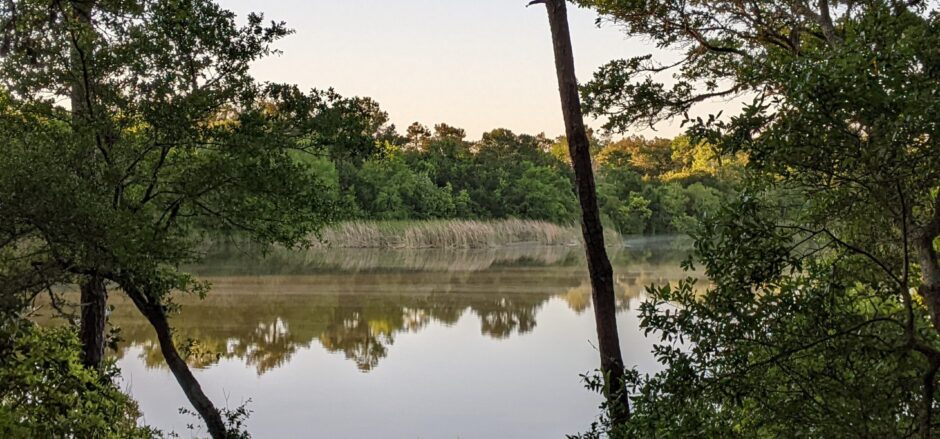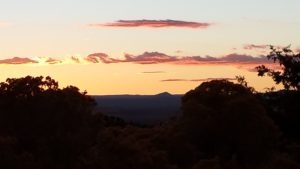One from the archives, posted in 2013, scenes excavated from one of my travel journals:
New York, April 2005. At MOMA, four panels by Kandinsky. The commentary says some interpret them as four seasons, but this was work “absolutely without descriptive purpose.” Considering that idea, I spot this woman and child, sit down to write with no purpose butdescription:
She’s thin, in her twenties, wears a stiff skirt splashed with pink and yellow flowers, cut full and short. The hem skims the tops of her white nylon knee-highs. Light cardigan of narrow blue and lavender stripes over a rumpled white T-shirt. She hoists her little girl to her chest. The child clasps her legs around her mother’s back. Her vinyl boots, bright orange with white polka dots, crunch her mother’s skirt. Mother and daughter are blonde, their straight hair pulled into hasty ponytails. The child sighs, rests her cheek on her mother’s shoulder. The mother stares intensely at the Kandinsky.
Querétaro, Mexico, 2006. El Cerro de las Campanas.A morning you only get above 6,000 feet—sweater cool, sherbet breeze, limpid sky. Jacarandas in violet fluted bloom. Indian laurel trees pruned into half-rounds line the path to the chapel, site of Maximilian’s 1867 execution. A towering black stone Benito Juárez commands the crest of the Hill of Bells, this quote carved into its base: Entre los individuos como entre las naciones, el respeto al derecho ajeno es la paz. Juárez, an indioin power among españoles, must have felt that truth to its marrow. Between individuals as between nations, respect for the rights of others is peace.
California Zephyr to San Francisco, June 2008 After Granby the conductor announces, “we just picked up the Colorado River and will follow it for over 200 miles.” Edward Hoagland says we go to water “for rest, refreshment, solace…In any landscape, in fact, a pond or creek catches and centers our attention as magnetically as if it were, in Thoreau’s phrase, ‘earth’s eye.’” So long as the Colorado runs beside us—wide, placid, perfectly reflecting the hills of the far side, or narrowing into rocks, descending, turning to white water froth—I seldom take my eyes off the bubbling swirls of its coppery current. A guy in the observation car says, “This is the river that made the Grand Canyon: give it a million years and it’ll turn this into one.”
On the mesa above Taos, June 2009. On arrival we sit beneath the casita’s portico soaking up silence, except for the occasional car on the Valdez Rim Road, all of whom Phil says are driving too damn fast. He rants about the lack of wifi, which we were supposed to have, and grumbles over the quirky electric stove. But we watch the sunset change the color of cloud and mountain and valley below. Phil said the clouds and flanks of the mountain would turn rosy once the sun dipped into that pale blue mountain range to the west and they do. He goes out to take a photo of the only house on the cliff side of the road, our landmark for finding this place. “It’s not an interesting house,” I comment. “I don’t care about the house. I want the way the light is going to flare on its eaves.” And in a moment, those eaves glow as if with inner fire.
On the train to Chicago, August 2010. At a small town in Iowa, an old guy in jeans and suspenders gets on with family, all of them obese. Talking about the flooding, he says, “our river’s been out of its banks for weeks,” points out the seed corn, how there’s three rows, then an empty row where the male plant was, which they remove after pollination. “And those,” he said, as some darker green came into view, “are soybeans. See how they’re a little burnt on top? That’s sudden death.” Later he saw some that looked good. “In another week they’ll start harvesting those and then they’ll be busy till the first freeze.” The commentary lasts until we reach outskirts of Chicago and run out of crops. Such knowledge is rare and archaic to me. How few of us in these times, know anything about what grows in a field.
Driving home from Kansas City, October 2011. Near Limon I discover a butte I’ve never seen before pushing above the southwestern horizon, a great rock in the distance, defiantly solitary. But it doesn’t conform to butte shape. Finally the swelling flank makes me realize: it’s Pike’s Peak, southern beacon of the Front Range. Then I-70 swings north, and as if balanced on scales, the rest of the range rises as Pike’s Peak sinks. By Deer Trail it slips out of sight and Mt. Evans lies ahead. That snowy high country, those powder blue foothills fill me with homecoming thrill every time.
Proust says a benefit of travel is “the temporary cessation of habit.” Habit puts us on autopilot, so we drive to work without knowing we’ve done it. Although I crave routine and sink into it like a warm bath, interrupting the everyday is a main motivation for travel. Coming home, I continue to see—for a day or two—as I saw Pike’s Peak, with new eyes.


Gorgeously observed and rendered scenes, Pat. I’m there with your comfortingly familiar voice! Thank you! Kitty
Always a delight to have your voice here! Thanks, Kitty.
Ah, yes, that first ‘welcome home’ view of the Rockies. Beautiful pictures, Pat.